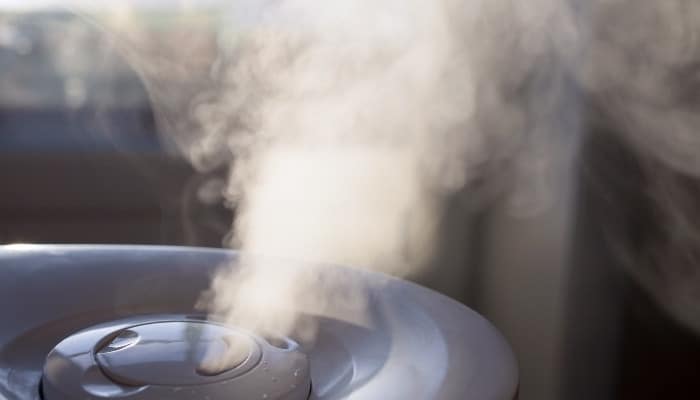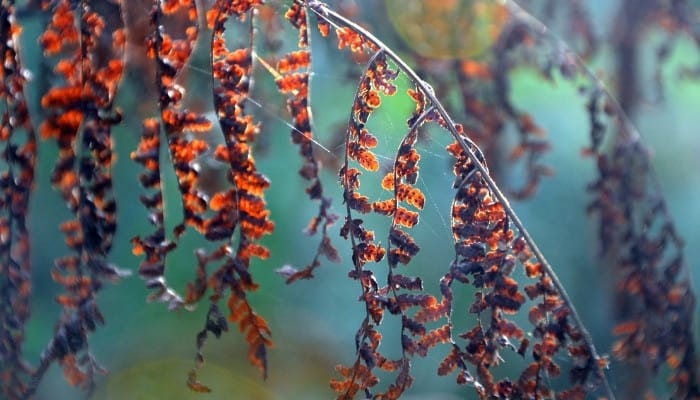With some planning and positive efforts, achieving the ideal humidity level for maidenhair ferns is easily attainable.
Without maintaining a good enough level of humidity for your ferns, they are as good as gone.
How much humidity do maidenhair ferns need? Maidenhair ferns require 50-70% humidity to remain healthy. To provide supplemental humidity, keep the fern’s soil consistently moist, run a humidifier, mist frequently, and place plant on a humidity tray or grow it in a terrarium. Provide only indirect sunlight.
Below, you’ll discover several easy options for maintaining the perfect humidity levels for your maidenhair ferns.
How To Provide the Perfect Humidity for Maidenhair Ferns
Ferns are not the hardest plants to care for, though they do have a reputation for being finicky and they require a certain level of humidity to live and thrive.
In the case of maidenhair ferns, a humidity level of 50% to 70% is necessary.
Providing the perfect humidity for maidenhair ferns is crucial. When the humidity level is too low, the air becomes dry and leaves, therefore, dry out as well.
Furthermore, low humidity causes evaporation rates to increase, leaving the leaves and soil much drier than is healthy for them.
Without the correct level of humidity, you must water your fern twice as much (or more) than would otherwise be necessary.
The danger in watering your plant so much is that root rot, pests, and harmful bacteria or disease may occur due to overwatering.
Don’t miss the chance to discover other common problems frequently encountered with maidenhairs. Check with this article to make sure you’re not inadvertently killing your fern.
Keep Soil Consistently Moist and Monitor Light Levels
Keeping your maidenhair fern’s soil consistently moist is a critical factor in whether or not the humidity of your plant stays high enough.
Likewise, the light levels that your plant receives also heavily impact the humidity level surrounding your fern.
The first step to keeping the soil consistently moist is using the right type of soil. An alkaline soil mix that includes large amounts of organic compost is preferred.
The next step is watering the soil thoroughly approximately once per week (or as needed so it doesn’t dry out).
A few ways that you can more easily control your soil’s moisture include:
- Mulching the top inch or two of the container.
- Infusing the soil with perlite or another water-absorbing material.
- Using a moisture meter (this one’s perfect) to monitor the soil.
- Keeping the soil protected from bright direct sunlight.
As far as light levels go, maidenhair ferns thrive in bright but indirect light. They prefer light all day long but no more than an hour or two of actual direct sunlight is suggested.
Otherwise, the soil will not stay consistently moist enough.
Use a Humidifier
Using a humidifier is highly recommended for growing and caring for maidenhair ferns indoors.
Not only does a humidifier keep the moisture level of the air surrounding the plant in good shape, but it also helps keep the soil moist enough in between watering sessions.
Most homes today have dry to semi-dry air; for that reason, a humidifier is your best bet for providing and maintaining perfect humidity levels for maidenhair ferns.
Additionally, using a humidifier will also improve the air quality and environment of your home in general (for you and for other plants as well).
That said, unless you keep a humidifier on full blast or use one with a rotating nozzle aimed right at the plant, the humidity levels directly around your ferns may need to be increased by regular misting, which we discuss in the next section.

Mist Frequently
One method for perfecting the humidity level for maidenhair ferns is to mist it frequently. Misting anywhere from two to four times a day helps most ferns to grow optimally and thrive in general.
However, avoid over-misting areas that are wrinkled or cracked as they may collect the moisture and begin to rot or develop fungal diseases.
If you’re misting frequently, keep a close eye on the moisture level of the soil. Misting regularly may keep the plant moist and humid enough to go a few extra days between waterings.
Failing to take soil moisture into consideration while misting may cause root rot or harmful fungus due to overwatering.
Keep Plant on a Pebble Tray
Another nifty trick for helping to maintain the level of humidity around your ferns is to keep them on a pebble tray.
Pebble trays, also known as humidity trays, are shallow dishes/containers that hold a small reservoir of water.
Evaporation from the water in the tray rises up through the air surrounding your plant. Pebble trays also help keep the soil in the bottom of the pot moist, thanks to evaporation rising up through the drainage holes.
There is a bit of controversy surrounding pebble trays and how much they actually increase humidity levels.
The bottom line? At the very least, a pebble tray may help maintain the humidity you create when you keep the soil moist, ensure proper lighting, mist regularly, and perhaps run a humidifier.
We explain it all here in this article and show you how easy it is to create your own pebble tray with household items.
Grow Maidenhair Ferns in a Terrarium
Growing maidenhair ferns in a terrarium is almost guaranteed to provide a healthy level of humidity for your plant. Most ferns do well in both open and sealed terrariums.
Your fern and terrarium should be placed near a window or in another brightly lit space. The terrarium and fern also need rotating from time to time, and make sure that you keep the glass clean of dust or water droplets.
Signs of Insufficient Humidity in Maidenhair Ferns

Below are a few of the most significant signs of insufficient humidity levels in maidenhair ferns:
Leaves Develop Brown Edges
If your maidenhair fern’s leaves are turning brown around the edges of their leaves, it is likely that your plant’s leaves are drying out due to a lack of sufficient humidity.
Wilting and Drooping
Drooping and wilting in ferns occurs when the plant is lacking a high enough level of humidity, even if you are watering it enough.
Yellow Leaves
Like wilting and drooping, your maidenhair fern’s leaves may begin turning yellow even with proper watering once humidity has dropped below proper levels.
Dry, Crispy Foliage
After your fern’s leaves turn brown around the edges due to lack of humidity, if not corrected in time, the remaining foliage may turn dry and crispy until it is completely fried.
Pro tip: If you want to know if your humidity is high enough, place ice cubes in a glass and check it 10 to 15 minutes later. If there are droplets of water on the outside of the glass, your humidity is not too low.
More Growing Tips for Maidenhair Ferns
- Keep fern on a window sill with indirect but bright sunlight all day.
- Use organic compost rich soil that drains well and retains moisture.
- Only fertilize lightly with 20-20-20 liquid fertilizer.
- Mist your fern 2 to 4 times per day.
- Water once every 5 to 10 days.
- Humidity level of 50% to 70%.
- Repot every 6 months to 1 year.
Related Questions:
Can Maidenhair Ferns Get Root Rot?
Overwatering, overmisting, using the wrong type of soil, planting in the wrong type of pot, and exposure to extreme humidity are a few of the most common factors that may cause your maidenhair ferns to get root rot.
Can You Overwater a Maidenhair?
Overwatering is just as much of a possibility with maidenhair ferns as it is with most plants, especially when growing them in pots.
Maidenhair ferns require waiting once every 5 to 10 days depending on the environment.
A Final Word
Creating and maintaining perfect humidity levels for your maidenhair ferns isn’t nearly as complicated as it may seem.
Hopefully, with all of the information and ideas above, you’ll have no problem keeping your fern thriving in a happy and healthy humidity level.

